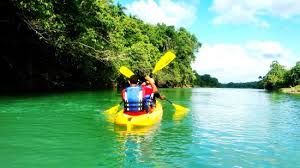Here’s the number: 90% of global consumers are looking for sustainable options when it comes to travel, indicating that trends are changing, according to Expedia. This change in thinking is booming due to the awareness of integrating sustainability into daily life, which means that leisure travel is included in this transformation.
The turquoise water welcomes 400 tourists a month looking to experience kayaking in Jamao al Norte, for about RD$1,700. The 5.3-kilometer-long route ends at the confluence of the Yásica and Jamao rivers, an activity that is gaining prominence in the Dominican Republic.
The local guides raise their voice to give instructions: “if you want to turn left, paddle to the right”. The sun’s rays tan the skin of the 20 journalists who live the experience of ecological tourism for three hours.
According to data from the World Travel and Tourism Council (WTTC), this type of tourism generates around US$600 billion annually, providing an opportunity for countries to diversify their economies while protecting biodiversity and their natural heritage.
In the Dominican Republic, Jamao Ecotours, a company located in the Espaillat province that develops sustainable tourism, stands out. “The venture is a community project, that is, 70% of the profits stay in the hands of the Espaillat community and 30% is directed to operating expenses,” explained its creator, Jairo Morillo.
According to the entrepreneur’s philosophy, the business must include the local community, who ensure that each tourist has a valuable, sustainable and enriching experience. Tourism continues to become one of the pillars of the local economy, generating 511,815 jobs and contributing US$8 billion in foreign exchange by 2022.
Model Change
While all-inclusive tourism allows mass mobilization, sustainability is emerging as an alternative for the domestic industry. This is indicated by statistics from the Ministry of Tourism (Mitur), highlighting that 23% of foreigners arriving in the Dominican Republic in January 2023 were adventurers.
This is followed by family tourists with 30%, seniors, 19%, and adults, 28%. The figures change when it comes to non-resident nationals. The adult traveler rose to 34%, followed by the senior (36%), adventurous (16%) and family (14%).
Nature provides destinations with unique identities and is a fundamental part of their appeal to tourists, as the World Travel and Tourism Council (WTTC) estimates that 80% of the sector’s goods and services depend on nature and ecosystem resources.
Community-based tourism
In addition to contributing to the conservation of protected areas, supporting sustainable development and community empowerment, the United Nations (UN) indicates that for every dollar spent on restoring areas, the global economy can gain between US$3 and US$75 in economic benefits from ecosystem goods and services.}
Morillo explains that the proximity to Puerto Plata is an advantage to attract foreign tourists who bet on an adventure experience. According to statistics from the state entity, the country welcomed 674,737 non-resident passengers in January 2023.
The data reflects that Punta Cana International Airport received 406,202 passengers, which represents 60.2% of the total, followed by Las Americas (141,125) and Santiago (62,149). Meanwhile, the Puerto Plata air terminal is in fourth place with 45,421 visitors, equivalent to 6.7%.
The tranquil flow serves as the border between the provinces of Espaillat and La Novia del Atlántico. According to Morillo, depending on the excursion, its price varies between RD$1,500 and RD$2,500 per person, which allows adventurers and nature lovers to have access to low-cost excursions.
Inclusion
With this travel model, the community should be impacted with the generation of jobs and its integration into the value chain.
“With the idea of creating a kind of business in which the community lives off tourism without affecting the environment, we conceived Jamao Ecotours,” Morillo said. His thinking is affirmed in the 186,000 companies that carry out activities related to tourism in the country, according to “Opportunities for MSMEs in tourism”.
The study prepared by the National Association of Hotels, Bars and Restaurants (Asonahores), states that 9% of these businesses are located in the Dominican tourist poles. This means 6,227 in Puerto Plata; 5,772 in La Romana and 4,834 in La Altagracia. Meanwhile, Espaillat registers 3,410 micro, small and medium-sized enterprises (MSMEs) that dedicate their operations to tourism.
Source: Mitur.gob.do
Learn more: NATURE

